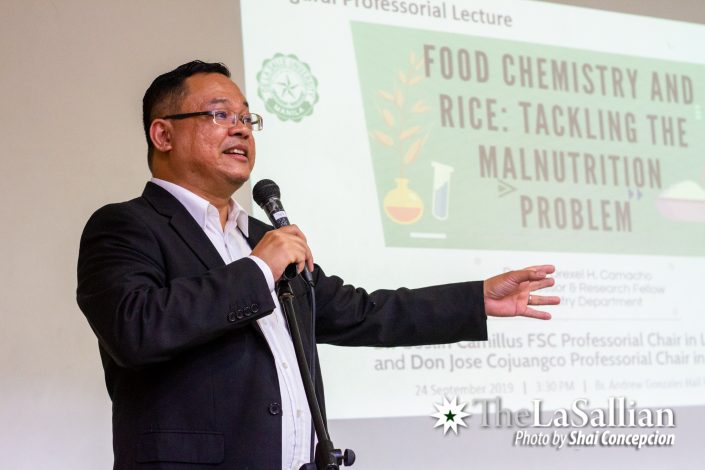Humanity has progressed across the years in countless aspects that are heavily attributed, but not limited to, technological breakthroughs, major economic developments, and a more streamlined agricultural process, materializing into a positive correlation between population growth and food production. However, undernutrition remains a pressing concern that plagues nations—most notably developing countries—across the planet.
Last September 25 in room 903 of Br. Andrew Gonzalez Hall, Dr. Drexel Camacho—a Research Fellow and a full professor from the Chemistry Department—conducted his professorial chair lecture about a rice fortification technique intended to address undernutrition, which refers to the inadequacies in an individual’s consumption of energy and nutrients.
Undernutrition has been a prevalent condition linked to poverty and it is presently a national issue in the country. It also begets several consequences from the individual level—including physical deformities, mental disorders, and stunted growth—to the societal scale manifested in increased mortality rates, lower work productivity, and higher risk of infection.
Wielding science
Rice is a staple in the diets of numerous cultures around the world, specifically in the Asian and African regions, being routinely consumed and comprising a substantial portion of people’s daily caloric requirements. The different rice varieties that are commonly produced and consumed in various communities worldwide, as listed by the International Rice Research Institute (IRRI), all undergo two principal processes: milling and polishing.

Camacho and his team have developed a comprehensive process that applies surface modification—a procedure involving the alteration of a particle’s surface—to fortify these rice varieties. The team adopted a surface modification method called sonication, a process wherein sound energy—usually in the form of ultrasonic frequencies—is utilized to agitate substances, essentially altering the surface features of each food particle. Camacho explains, “After performing sonication on the commercial white rice that is available in the market, we attach the iron by oxidizing the rice grains.”
Prior to the team’s approach, the general methodology of rice production begins with paddy rice undergoing the milling process to remove the hard and protective coating, also known as the hull, that covers each individual grain.The milling process dehulls the paddy rice by utilizing friction caused by two abrasive surfaces varying in speed and coming into contact with one another. The end product is brown rice, which is a variety of rice that has been dehulled but retains its bran coating, the fiber-rich external layer that gives it a coarse and chewy texture. The bran contains an abundant supply of nutrients, including B vitamins, iron, copper, zinc, magnesium, and phytochemicals—natural chemical compounds that reportedly have active properties associated with disease prevention and cure.
Although brown rice evidently contains more nutrients, it has not garnered as much popularity in comparison with the most prevalent rice variety, white rice.
White rice, also known as refined rice, is a brown food grain that has undergone further processing through polishing or whitening. Coarse-grained polishers are used to remove the bran layer and embryo, thus leaving only the starchy and white endosperm—hence its namesake. Although the most commercially available, white rice has arguably lost much of its nutritional value, apart from being a good carbohydrate or energy source, relative to the higher vitamin, mineral, and fiber content that natural and less processed grains can offer.
What Camacho and his team appended to this process was a manner of modifying the surface of the food grains by means of sonication, effectively increasing the grains’ capacity to become fortified with nutrients.

“The x-ray tomography shows that sonication imparted cracks and fissures on the rice grain. This turned the [rice grain] endosperm translucent which is a result of the acoustic cavitation that was caused by the sonication process,” Camacho elaborates as he shows images of the food grains that underwent the sonication process.
Upon utilizing this methodology in rice grains, the researchers were able to promote micropore formation to induce high adsorption for better moisture retention; cell wall exposure which causes water to pass more freely into each grain; and scattering of starch granules, which are energy-packed carbohydrate reserves. These parameters effectively amplify key characteristics such as the porosity, adhesiveness, absorptive capacity, and firmness of the rice.
Augmenting these characteristics enabled Camacho and his team to dramatically fortify the sonicated rice grains with a 28 percent increase in iron uptake via iron oxidation, effectively boosting its nutritional composition.
Pushing boundaries
Supported by further analysis, Camacho’s team discovered that there have been little to no studies conducted on the inherent amount of folate, a type of B vitamin that is fundamental for cellular reproduction and growth, available in IRRI rice varieties. This led their team to quantify the total folate content of the 20 rice varieties listed by the IRRI by utilizing tri-enzyme extraction. Upon characterization, the rice variety with the lowest content rating was subject to folate fortification experiments.

After ultrasonic treatment and a gradual fortification process, a 4,054 percent increase in folate content was achieved, along with a higher retention rate. Through further analysis, the team was also able to verify that the palatability of brown rice was also enhanced by reducing its firmness and improving its adhesiveness—thus, achieving favorable textural properties while also augmenting the nutrient retention of the food grains. Overall, the collective surface modification tests and experiments resulted in an approximate thousand-fold increase in nutrients.
As of writing, Camacho and his team are in the process of developing their prototype of fortified rice grains that may be commercially sold in the near future under their established brand, Forti Grains. “Our healthy and nutritious rice does not only incorporate minerals but also vitamins that could benefit people of different age groups—from young children to pregnant women,” he affirms. The team is also awaiting certification from the Food and Drug Administration of the Philippines along with a pending patent on the fortification process. Upon inquiry, Camacho reveals that the newly developed fortified rice grains will cost approximately P2 to P5 more per kilogram, as compared to the commercial rice grains being sold in the market.
However, despite being able to address the ramifications caused by nutrient deficiencies, making the product accessible to the people who need it most may present another challenge entirely, with poverty remaining rampant as a possible roadblock. This approach, once refined, will hopefully serve as one of the key initiatives that may be put in place to aid in alleviating issues related to food security and nutrition.
